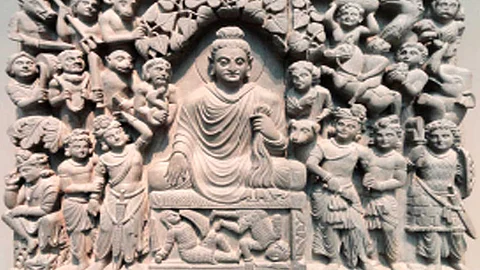
- முகப்பு
- கல்கி
- மங்கையர் மலர்
- தீபம்
- கோகுலம்/Gokulam
- முக்கிய பிரிவுகள்முக்கிய பிரிவுகள்
- தொகுப்புகள்தொகுப்புகள்
- Premium

The Kushanas were a section of the Yueh-chi clan who were nomads living near modern China. After the second century B.C., they migrated westwards and much later settled down in the present-day Afghanistan. The first few famous Kushan kings are Kadphises I (c.15-65 A.D.), Kadphises II (c.65-75 A.D.) and Kanishka (c. 127 A.D.). Kanishka’s empire consisted of large parts of Afghanisthan, Pakistan and North India. This empire came to an end around 230 A.D.
The capital of Kanishka’s empire was Purushapura (modern Peshawar). Kanishka beautified his capital with many Buddhist monasteries as he himself was an ardent follower of Buddhism. One of the structures in Purushapura was a huge relic tower, the superstructure of which was carved out of rosewood, rising to a height of about 400 feet in thirteen storeys. There was a monastery attached to this tower.
Kanishka worked hard to spread Buddhism. He erected many Stupas throughout his empire containing relics of Buddha or of great Buddhist teachers. He also built new Buddhist monasteries and repaired old ones. The fourth Buddhist Council was convened during his reign.
There was a major transformation in Buddhism during the time of Kanishka. The Hinayana form of Buddhism, in which Buddha was worshipped only in the form of symbols, was replaced by Mahayana Buddhism in which Buddha came to be worshipped in the form of statues. Beautiful images of Buddha, carved out of schist stone, came to be sculpted in the Gandhara region (Present-day Afghanisthan). This type of sculpting was popularly known as the Gandhara School of Art. Gandhara art had a Greek and Roman influence as this region was ruled over by the Greeks after Alexander’s invasion. It was the meeting place of the East and theWest and hence, Buddhism that travelled from India, found a place
there and images of Buddha came into existence.
The Mathura School of Art also flourished during the Kushana times with Mathura (Uttar Pradesh) as the main centre. Here too, sculptures of the Buddha, Bodhisattvas (enlightened beings of Buddhism) and also Jain Tirthankaras like Vardhamana Mahavira, were made. Influence of the Gandhara School of Art can clearly be seen on the sculptures of Mathura. The Mathura-style sculptures were made of red sandstones.
Some stone sculptures, made of red sandstones, of Kushana kings, have been discovered in a place called Mat (pronounced Maat) about 14 kms from Mathura, on the eastern bank of River Yamuna. They were found in a temple where the sculptures of Kadphises, Kansihka and Huvishka (successor of Kanishka) were worshipped. The sculpture of Kanishka measures about 170 cm and is in a standing posture. He wears a long coat and heavy shoes and is seen holding a mace. There is an inscription on this statue that gives his name and mentions him as Maharaja. The Kushan coins are very famous.
They portray Indian, Greek and Iranian deities and also figures of the Kushan kings.
